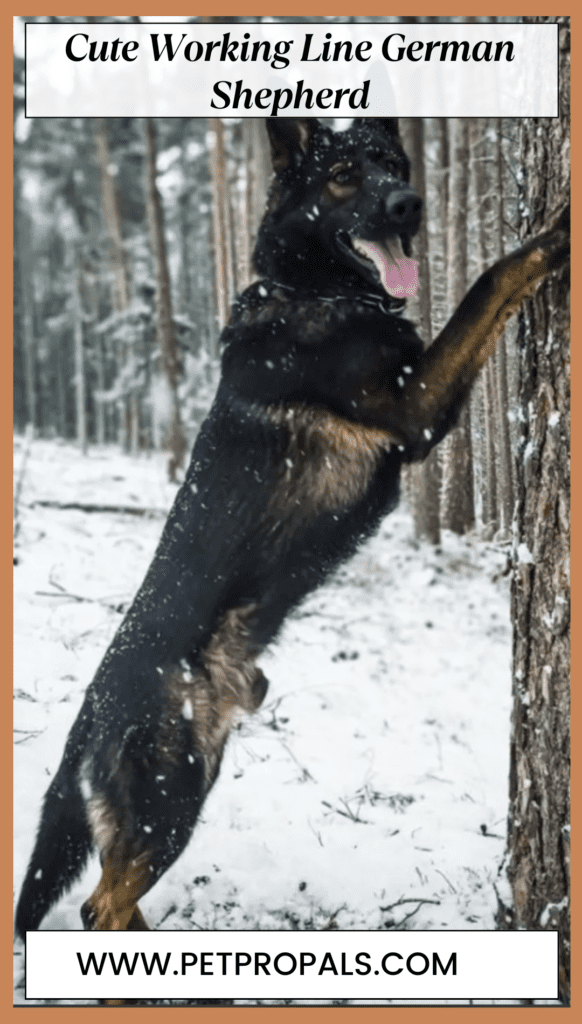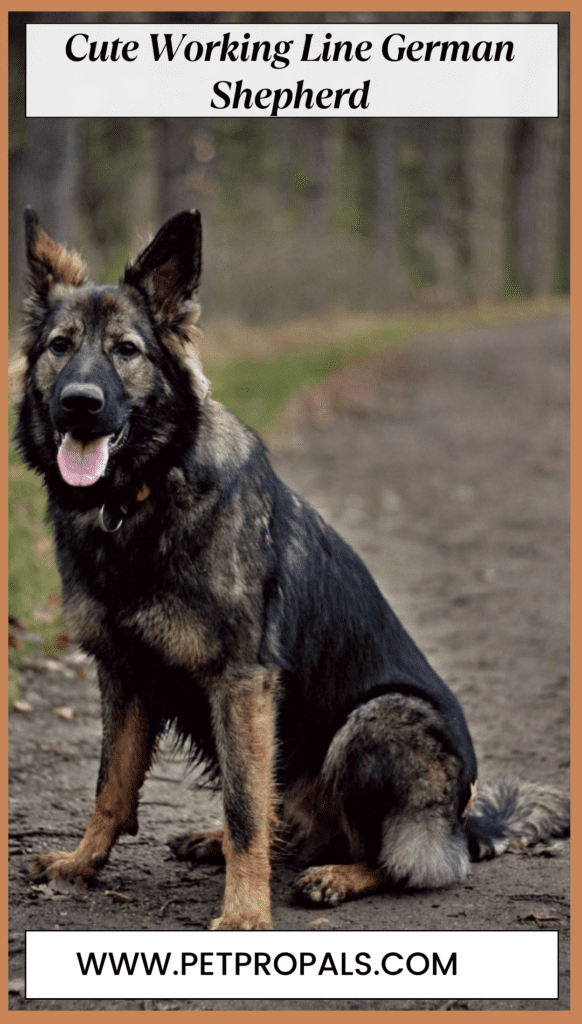Have you ever wondered what sets working-line German Shepherds apart from their show line counterparts?
German Shepherds are one of the world’s most popular and versatile dog breeds.
Known for their intelligence, loyalty, and agility, these dogs have made a significant impact as both beloved pets and valuable working partners.
Working line German Shepherds, in particular, are bred with a focus on performance, temperament, and ability rather than appearance.
These dogs excel in various demanding roles such as police work, search and rescue, military service, and competitive sports.
Their breeding emphasizes traits like drive, stamina, and obedience, making them exceptional at tasks requiring mental and physical endurance.
This article aims to uncover the exceptional characteristics and advantages of working line German Shepherds.
We’ll uncover their unique attributes, delve into the diverse roles they succeed in, and illustrate why they could be your ideal choice if you’re searching for a dog that is not only highly capable and trainable but also a loyal companion ready for any challenge.
Read Also: Is a German Shepherd Rottweiler Mix Right for You? Read This First!
What is a Working Line German Shepherd?

A working line German Shepherd is a type of German Shepherd bred for their ability to work rather than their appearance in dog shows.
These dogs are chosen for traits like drive, stamina, intelligence, and how easily they can be trained.
They are used for jobs such as police work, search and rescue, protection, herding, and competitive sports.
Differences between Working Line and Show Line German Shepherds
The main difference between working line and show line German Shepherds is why they are bred.
Working line German Shepherds are bred for their skills and temperament, while show line German Shepherds are bred to look a certain way and move well in dog shows.
Working line dogs often have more energy and a stronger drive than show line dogs.
Learn more in our dedicated article on Working Line vs Show Line German Shepherds.
Historical Background of Working Line German Shepherds
Working line German Shepherds trace their origins to Germany in the late 19th and early 20th centuries.
The breed’s development is credited to Captain Max von Stephanitz, who sought to create a versatile and intelligent herding dog capable of assisting farmers with their livestock.
In 1899, von Stephanitz founded the Verein für Deutsche Schäferhunde (Society for the German Shepherd Dog), which became the breed’s official governing body.
Von Stephanitz emphasized the importance of utility and intelligence over appearance, breeding German Shepherds who excelled in herding and guarding tasks.
These early dogs were known for their loyalty, trainability, and adaptability, making them valuable working companions.
During World War I, German Shepherds gained international recognition for their service as messenger dogs, guard dogs, and Red Cross assistants.
Their exceptional performance during the war further solidified their reputation as reliable working dogs.
After the war, German Shepherds continued to prove their versatility in various roles, including police work, search and rescue missions, and military service.
Their intelligence, obedience, and physical prowess made them indispensable in demanding and often dangerous situations.
Today, working line German Shepherds are bred for their working abilities rather than appearance.
They are highly sought after for their dedication, stamina, and capability to excel in various tasks, making them one of the most respected and utilized working dog breeds worldwide.
Physical characteristics of working line German Shepherds

Working line German Shepherds are known for their athletic build and strong, muscular appearance.
They typically have a straight back and powerful hindquarters, contributing to their agility and endurance in various tasks.
Their coats are usually dense and double-layered, providing insulation and protection from weather conditions.
These dogs have distinct, wedge-shaped head with a moderately pointed muzzle.
Their ears are erect and alert, enhancing their ability to pick up sounds during work activities.
The eyes of working line German Shepherds are almond-shaped and dark, reflecting their attentive and intelligent nature.
In terms of size, male working line German Shepherds typically stand between 24 to 26 inches (61 to 66 cm) tall at the shoulder, while females are slightly smaller, ranging from 22 to 24 inches (56 to 61 cm).
They usually weigh between 65 to 90 pounds (29 to 41 kg), with males being heavier than females on average.
Overall, the physical characteristics of working line German Shepherds reflect their strength, agility, and suitability for demanding roles such as police work, search and rescue, and protection tasks.
Temperament and Behavior Traits of Working Line German Shepherds
Working line German Shepherds are renowned for their exceptional temperament and behavior traits that make them ideal for various roles:
- Intelligence and Trainability: These dogs are highly intelligent and quick to learn, making them excellent for tasks like police work and search and rescue operations.
- Loyalty and Protection: Known for their loyalty and protective instincts, they form strong bonds with their handlers and excel as guardians.
- Confidence and Courage: They exhibit confidence and courage in challenging situations, which is crucial for roles requiring bravery and composure.
- Energy and Stamina: With high energy levels and impressive stamina, they thrive on physical activity and mental stimulation.
- Adaptability and Versatility: Their adaptability allows them to perform well in diverse environments, from urban patrols to rural tasks.
Lifespan and Health Considerations of Working Line German Shepherds
Working line German Shepherds typically live between 10 to 14 years. While generally healthy, they may be prone to:
Common Health Issues:
- Hip and Elbow Dysplasia: Joint problems that can cause discomfort and lameness.
- Degenerative Myelopathy: A spinal cord disease leading to hind limb weakness.
- Exocrine Pancreatic Insufficiency (EPI): Lack of digestive enzymes affecting nutrient absorption.
Additional Concerns:
- Bloat: A serious condition requiring immediate veterinary attention.
- Allergies and Skin Conditions: Prone to allergies and skin irritations.
Regular veterinary check-ups, a balanced diet, and proper exercise help ensure their well-being and longevity.
Care and Training of Working Line German Shepherds

Working line German Shepherds require specific care and training to thrive in their roles and as family companions:
Exercise Needs
These dogs have high energy levels and require regular exercise to stay healthy and happy.
Daily walks, playtime, and mentally stimulating activities like obedience training or agility courses are essential to prevent boredom and behavior issues.
Mental Stimulation
Their intelligence demands mental challenges. Engage them with puzzle toys, scent work, or obedience training sessions to keep their minds sharp and satisfied.
Socialization
Early and ongoing socialization is crucial to prevent them from becoming overly protective or wary of strangers.
Expose them to various people, animals, and environments from a young age to promote confidence and good behavior.
Grooming
Working line German Shepherds have a double coat that sheds moderately year-round, with heavier shedding during seasonal changes.
Regular brushing helps minimize loose hair and keeps their coat healthy. They may also benefit from occasional baths and nail trimming.
Training and Obedience
They excel in obedience training due to their intelligence and willingness to work.
Positive reinforcement techniques, such as treats and praise, work best to reinforce good behavior and commands.
Consistency and patience are key to developing a well-behaved companion or working dog.
Identification and Verification of Working Line German Shepherds
Identifying a true working line German Shepherd involves understanding key characteristics and verifying their lineage:
Physical Characteristics
Working line German Shepherds typically have an athletic build with a straight back and strong hindquarters.
They exhibit a wedge-shaped head, erect ears, and dark, almond-shaped eyes.
Their coats are double-layered and often dense, providing insulation and protection.
Temperament and Behavior
These dogs are known for their intelligence, high energy levels, and strong work ethic.
They display confidence, courage, and loyalty, making them well-suited for various working roles such as police work, search and rescue, and protection.
Lineage and Pedigree
Examine their pedigree and lineage records to verify a working line German Shepherd.
Responsible breeders prioritize working abilities over appearance, breeding dogs with proven performance in tasks like obedience trials or service work.
Training and Performance
Assessing the dog’s training and performance in specific tasks can further confirm their working line status.
They should demonstrate proficiency in obedience, agility, scent detection, or other relevant skills related to their intended role.
Cost and Purchase Considerations of Working Line German Shepherds
When considering acquiring a working line German Shepherd, several factors influence cost and purchase decisions:
Initial Cost
The initial cost of a working line German Shepherd puppy can vary widely depending on factors such as lineage, breeder reputation, location, and the specific role for which the dog is intended (e.g., police work, search and rescue). On average, prices range from $1,500 to $3,500 or more.
Breeder Reputation and Ethics
Choosing a reputable breeder is crucial. Responsible breeders prioritize their dogs’ health, temperament, and working abilities.
They conduct health screenings, provide proper socialization, and maintain detailed records of lineage and certifications.
Ongoing Expenses
Owning a working line German Shepherd entails ongoing expenses beyond the initial purchase.
These may include veterinary care (vaccinations, routine check-ups), high-quality dog food, grooming supplies, training classes, and potential costs associated with their working activities (e.g., specialized equipment).
Purpose and Suitability
Consider the intended role and environment for the dog. Working line German Shepherds thrive in active households or working environments where they can utilize their intelligence and energy.
Assessing their temperament and ensuring compatibility with your lifestyle is essential for a successful partnership.
Adoption and Rescue Options
Adoption or rescue organizations occasionally have working line German Shepherds available for adoption.
This can be a cost-effective option that provides a loving home to a dog in need, although a thorough assessment of the dog’s background and temperament is advisable.
Suitability of Working Line German Shepherds as Pets
Working line German Shepherds can make wonderful pets under the right circumstances, but their suitability depends on several factors:
Energy Level and Exercise Needs
These dogs have high energy levels and require regular exercise and mental stimulation to stay happy and healthy.
They thrive in active households where they can participate in activities like running, hiking, or agility training.
Training and Socialization
Due to their intelligence and strong work ethic, working line German Shepherds benefit from consistent training and positive reinforcement methods.
Early and ongoing socialization is essential to ensure they develop good manners and adapt well to various people and environments.
Loyalty and Bonding
Known for their loyalty and strong bonds with their families, working line German Shepherds are protective and devoted companions.
They thrive on being part of the family and excel in roles where they can work closely with their owners.
Behavioral Considerations
These dogs may exhibit behaviors such as herding instincts, alertness, and natural protective instincts.
Proper training and socialization help channel these traits positively, ensuring they are well-behaved and confident in different situations.
Commitment to Mental Stimulation
Their intelligence requires mental challenges to prevent boredom and potential behavior issues.
Engaging them with interactive toys, obedience training, or tasks stimulating their minds is essential for their well-being.
Practical Advice for Owners of Working Line German Shepherds
Owning a working line German Shepherd requires careful consideration and dedication to meet their specific needs.
Here are practical tips for ensuring a happy and healthy relationship:
Exercise and Mental Stimulation
Provide daily exercise sessions such as brisk walks, jogging, or active play sessions to fulfill their high energy levels.
Mental Stimulation: Engage their intellect with puzzle toys, obedience training, scent work, or agility exercises to prevent boredom and promote mental sharpness.
Consistent Training and Socialization
Positive Reinforcement: Use rewards like treats and praise to reinforce desired behaviors and commands.
Consistent training builds trust and strengthens the bond between you and your dog.
Early Socialization: Expose your German Shepherd to various people, animals, and environments from an early age to promote confidence and good behavior in different situations.
Health and Nutrition
Regular Veterinary Care: Schedule routine check-ups, vaccinations, and preventive care to maintain overall health and catch potential issues early.
Balanced Diet: Feed a high-quality diet appropriate for their age, size, and activity level.
Monitor their weight and adjust portions as needed to prevent obesity.
Grooming and Maintenance
Coat Care: Brush their double coat regularly to minimize shedding and keep their fur healthy.
Bathing should be done as needed to keep them clean and comfortable.
Nail Trimming: Keep their nails trimmed to a comfortable length to prevent discomfort and potential issues with walking.
Safety and Security
Secure Environment: Ensure your home and yard are secure, as German Shepherds are known for their protective instincts.
Provide a safe space where they can relax without feeling threatened.
Training for Specific Roles: If using your German Shepherd for work purposes like protection or search and rescue, ensure they receive specialized training appropriate for their role.
Working Disciplines
Working line German Shepherds are highly versatile and excel in various working disciplines. Here is an overview of some key areas where they shine, along with the training and skills required for these roles:
Overview of Working Disciplines
Schutzhund
Schutzhund, or IPO, is a dog sport that tests a dog’s tracking, obedience, and protection skills. It was originally developed in Germany to evaluate the breed’s suitability for work.
Training and Skills Required:
- Tracking: The dog must be able to follow a scent trail with precision.
- Obedience: High levels of discipline and the ability to perform commands accurately.
- Protection: The dog must protect its handler on command, showing control and restraint.
Search and Rescue (SAR)
German Shepherds are commonly used in SAR operations to locate missing persons in various environments, including urban, wilderness, and disaster scenarios.
Training and Skills Required:
- Scent Detection: Training to track human scents over long distances and challenging terrains.
- Agility: Ability to navigate obstacles and rough terrain.
- Obedience and Focus: Following commands and maintaining concentration in chaotic environments.
Police Work
German Shepherds are widely used in law enforcement for tasks such as suspect apprehension, narcotics detection, and patrol duties.
Training and Skills Required:
Obedience and Control: High level of obedience training to respond accurately to commands.
Detection Skills: Specialized training in detecting drugs, explosives, or contraband.
Apprehension and Protection: Training in safely apprehending suspects and protecting their handlers.
Military Service
German Shepherds serve in the military as patrol dogs, detection dogs, and for specialized roles like tracking and explosives detection.
Training and Skills Required:
Patrol and Guarding: Skills in protecting military personnel and property.
Detection: Training in identifying explosives, weapons, and other threats.
Combat Readiness: Ability to operate in high-stress, potentially dangerous environments.
Competitive Sports
Beyond work roles, German Shepherds excel in competitive dog sports like agility, obedience trials, and herding competitions.
Training and Skills Required:
Agility Training: Navigating obstacle courses quickly and accurately.
Obedience Trials: Performing commands and routines with precision.
Herding Skills: Instinctive ability to manage livestock, refined through training.
Potential Challenges and Solutions for Working Line German Shepherds
Working line German Shepherds are exceptional dogs, but they come with specific challenges that prospective owners should consider:
High Energy Levels
Challenge: Working line German Shepherds have high energy levels that require regular exercise and mental stimulation to prevent boredom and behavior issues.
Solution:
Exercise Routine: Establish a consistent exercise routine, including daily walks, runs, or active play sessions to expend their energy.
Mental Stimulation: Engage their minds with puzzle toys, obedience training, or scent work to keep them mentally challenged and fulfilled.
Potential for Protectiveness
Challenge: These dogs can exhibit natural protectiveness towards their family and territory, which may lead to wary behavior around strangers if not properly socialized.
Solution:
Early Socialization: Start socialization from a young age to expose them to various people, animals, and environments in positive settings.
Positive Experiences: Encourage positive interactions with strangers through controlled introductions and rewards for calm behavior.
Need for Experienced Handlers
Challenge: Due to their intelligence and strong personalities, working line German Shepherds benefit from experienced handlers who can provide consistent leadership and training.
Solution:
Professional Training: Consider enrolling in obedience classes or seeking guidance from experienced trainers who understand the breed’s needs.
Consistency and Patience: Maintain consistent training methods with clear expectations and positive reinforcement to build trust and respect.
Tips for Overcoming Challenges
Establish Routine: Create a structured daily routine for exercise, feeding, training, and playtime to provide stability and meet their needs.
Monitor Health: Regular veterinary check-ups and preventive care help maintain their physical health and catch any issues early.
Secure Environment: Ensure fences are secure and supervise interactions to manage their protective instincts responsibly.
Positive Reinforcement: Use rewards like treats, praise, and affection to reinforce desired behaviors and build a strong bond with your German Shepherd.
Conclusion
Working line German Shepherds stand out for their intelligence, loyalty, and robust physical abilities, making them ideal for various challenging roles.
Bred for performance rather than appearance, these dogs excel in tasks like police work, search and rescue, and competitive sports.
Their innate drive and trainable nature ensure they thrive in environments demanding both mental agility and physical endurance.
Whether as dedicated working partners or beloved family pets, their unwavering loyalty and impressive skills continue solidifying their reputation as one of the most versatile and capable dog breeds worldwide.
FAQs
What are working line German Shepherds bred for?
Working line German Shepherds are bred primarily for their working abilities rather than their appearance in dog shows.
They excel in tasks such as police work, search and rescue missions, protection duties, herding, and competitive sports due to their intelligence, agility, and strong work ethic.
How do working line German Shepherds differ from show line German Shepherds?
The main difference lies in their breeding objectives. Working line German Shepherds are selected for their performance, temperament, and suitability for specific tasks.
In contrast, the showline German Shepherds are bred to conform to the breed standard and excel in conformation shows based on their appearance and movement.
What is the lifespan of a working line German Shepherd?
Working line German Shepherds typically live between 10 to 14 years, depending on factors such as genetics, healthcare, and overall lifestyle.
Proper nutrition, regular exercise, and routine veterinary care can contribute to longevity.
Are working line German Shepherds good as family pets?
Yes, working line German Shepherds can make excellent family pets under the right circumstances.
They are loyal and protective and often bond closely with their families.
High energy levels and the need for mental stimulation require dedicated exercise, training, and socialization from an early age to ensure they thrive in a home environment.
What are the common health issues in working German shepherds?
Like all dog breeds, working line German Shepherds may be prone to certain health conditions, including hip and elbow dysplasia, degenerative myelopathy, and exocrine pancreatic insufficiency (EPI).

